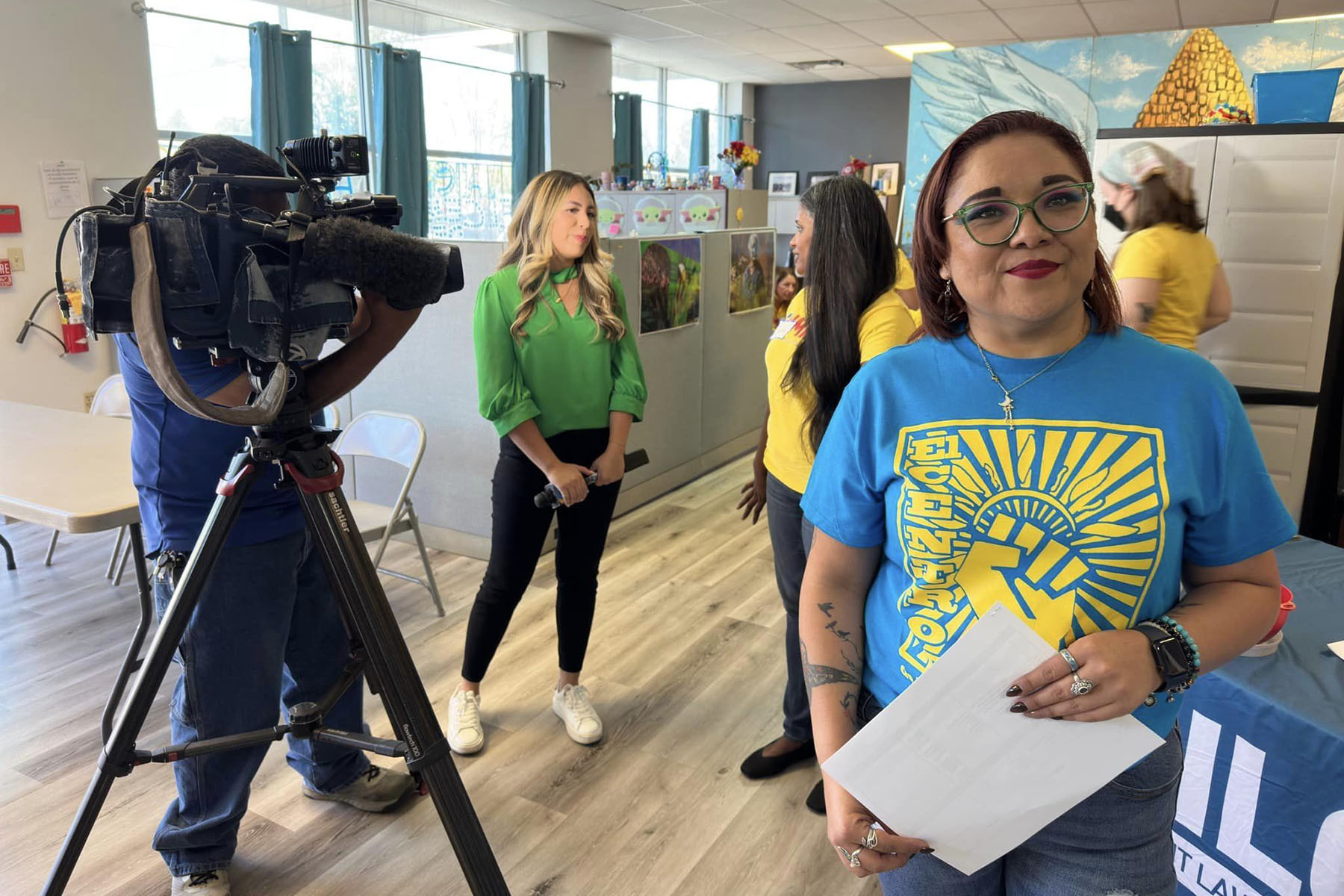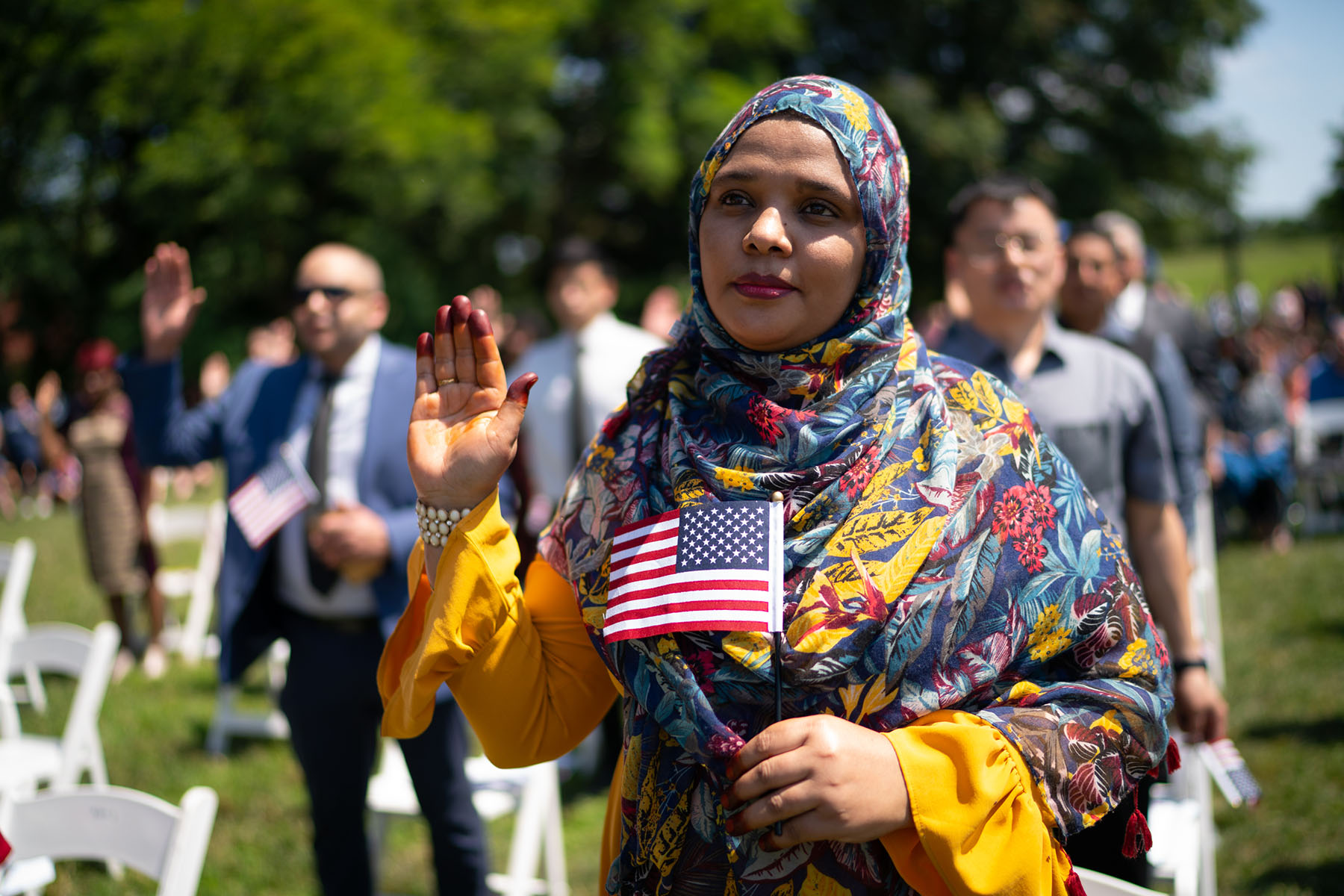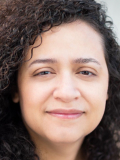The 19th is committed to covering the unfinished business of voting rights. Read more about how we’re approaching that in this pivotal election.
When Becky Insook Kim immigrated to the United States from Korea in 1995, she was a 37-year-old mother of two who soon had a job as a cashier at a cleaner’s in Souderton, Pennsylvania, about 35 miles north of Philadelphia.
“In her head, she thought she would have a better job and more opportunities,” said Alice Min, Kim’s adult daughter. Min interpreted for her mother, who spoke Korean during a recent interview. “She had to work 16-hour shifts to just provide food for our family. And it was more struggles than what she thought.”
In March — nearly 30 years after she first came to the United States — Kim became a U.S. citizen. This election cycle will mark her first as an eligible voter, and she plans to vote in Texas, where she resides.
“She is very excited to raise her voice as a U.S. citizen,” Min said of her mother’s voting plans. “She still cannot believe that she is a U.S. citizen.”
In a pivotal election year where the presidential contests in some battleground states may be decided by a few thousand votes, the turnout of eligible immigrant women voters — some of whom say they’re mindful of how immigration policy is being debated — could decide the outcome of the rematch between President Joe Biden and former President Donald Trump.
Immigrant voters are not monolithic, but they have also shown more support for the Democratic Party.
And the Democratic Party has generally in recent years had more immigrant-friendly policies. Biden announced plans this month to reduce deportations of the spouses of U.S. citizens and to let some immigrants who arrived here as children to more quickly receive work visas. Biden has also supported some Trump-era restrictions on asylum seekers at the U.S.- Mexico border.
Trump, who was recently convicted of 34 felony counts related to falsified business records tied to the 2016 election, has promised to deport millions of undocumented immigrants if he’s reelected. He has also attempted to spread disinformation about noncitizen voting in federal elections, which is virtually nonexistent.
Newly naturalized citizens like Kim are a growing share of the American electorate — since the 2020 election, an estimated 3.5 million immigrants have become naturalized U.S. citizens. Fifty-five percent, or nearly 2 million people, are women.
An impromptu network of immigrant women leaders have been credited with helping their communities with citizenship services. But the reason for the gender gap may come down to who is able to complete the lengthy naturalization process.
“The main reason there are more women naturalizing than men is there are more women eligible to naturalize than men, because there are more legal immigrants who are women,” said Jeff Pastel, a senior demographer at the Pew Research Center.
In addition, immigrant men appear to be deported at a higher rate than immigrant women, in part because they’re arrested at a higher rate.
“The big thing is, who’s allowed to get to the finish line?,” said Nancy Flores, deputy director for the National Partnership for New Americans (NPNA), a national organization that promotes immigration equity in policy and is promoting a campaign to register more newly eligible immigrant voters ahead of the November election. She has seen firsthand how women are propelled to the head of their households because of deportations that target their spouses and partners.
“That does pull people into being more active and saying, ‘I’m not OK with just becoming a green card holder. I need to ultimately become a citizen,’” Flores added.
These are not new motivations. When Obdulia Alvarez applied for citizenship more than 20 years ago, she was a single parent with two young daughters. One of those children was Flores.
Alvarez immigrated to the United States from Mexico, the top country of origin for newly eligible voters. After a brief stint in California, she brought her children to rural Wisconsin. She knew quickly she wanted to become a U.S. citizen.
“I was thinking of my kids,” Alvarez said on her reasoning. “I was thinking, ‘I need to get my citizenship. I have to vote.’”
Alvarez said that since her first visit to a polling place as an eligible voter in the late 1990s, she has tried to never miss an election. She also encourages people who attend her church to get out and vote.
Naturalized citizens are less likely to register to vote than U.S.-born citizens, according to research published in 2016. Among the reasons: fear, a lack of information and language barriers.
But the same 2016 research concluded that once newly eligible voters are registered, they vote at similar rates to U.S.-born citizens.
Flores believes another reason women are becoming naturalized citizens at a higher rate is because women tend to lead community outreach that helps people with immigration and citizenship services. Flores said that creates a loop in which they’re more likely to have the information they need to begin the lengthy application process.
“We’re seeing that a lot of them are really the ones that are kind of taking leadership and saying, ‘Naturalization has transformed my life. I really kind of want to pay it forward,’ Flores added. “So we’re seeing a lot of these wonderful ‘community navigators’ becoming citizens themselves and then also being part of cohorts that are then getting deputized on naturalization and going out there in the community.”

It’s how Fabiola Landeros, a community organizer in New Mexico, began her citizenship journey. She was connecting immigrants with citizenship services through an organization called El Centro — but she was not a U.S. citizen. A single mother to three children, Landeros said it was her kids who persuaded her to reconsider her immigration status.
“My kids turned to me and they were like, ‘Hey mom, when are you going to become a U.S. citizen? The work that you do, we see that many organizers are targeted. And the last thing we want is for you to get deported,’” she recalled, noting that noncitizen organizers can inadvertently get on the radar of immigration officials.
The conversation set Landeros into action. She became a naturalized citizen in 2019 — in time for her to vote alongside her oldest, who was 18 at the time. She brought along her two younger kids to the polling place. She said she hasn’t missed an opportunity to vote since then.
“I wanted to make sure that they see the importance of going in and voting,” she said.
The issues propelling immigrant women to vote this election varies. For Kim, it’s wage equity. For Alavarez, it’s “a better government.” Landeros said immigration is a top issue for her, and she wants politicians to stop scapegoating immigrants.
“It motivates me when I hear people that are really talking about real plans to work with immigrants, undocumented communities, that they really want to do something to make sure that the people that are already living here as immigrants or refugees or asylum seekers, have a chance, to have a pathway to citizenship,” she said. “The system right now, it doesn’t work for communities.”
The effort by NPNA to register newly eligible immigrant voters — they’re targeting the estimated 3.5 million naturalized citizens since the last presidential election — includes partnerships with organizers on the ground in several battleground states.
“This is a voting bloc that uniquely has earned their citizenship,” Flores said. “When we look at a community that has to work toward something, there are always the superheroes that help to make that happen, that help to pull the community in that direction. Women have certainly played a pivotal role in that. We’re seeing it in the numbers, we’re seeing it in the advocacy, we’re seeing it in the community.”
Data visuals reporter Jasmine Mithani contributed to this report.








